

256 km Grafton Radar Loop. Cure for mitochondrial disease is on the horizon but it involves cloning. Oregon Health and Science University scientists have created a repair kit for brains, muscles and hearts ravaged by mitochondrial diseaseThis group of genetic illnesses can trigger miscarriages and stillbirthsBut breakthourgh raises the spectre of babies being cloned to orderScientists stress their aim's to provide a treatment for seriously ill children By Fiona Macrae for the Daily Mail Published: 17:04 GMT, 15 July 2015 | Updated: 20:06 GMT, 15 July 2015.

All The Reasons To Clone Human Beings. By Simon Smith Medical breakthroughs - Human cloning technology is expected to result in several miraculous medical breakthroughs.
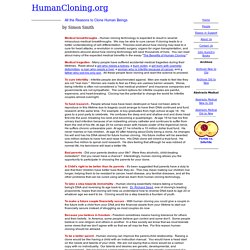
We may be able to cure cancer if cloning leads to a better understanding of cell differentiation. AGreenRoad Project - Teaching A Science Of Sustainable Health/Success: Human Fertility Clinics Drive Human Cloning Attempts - At $50,000 Per Attempt, It Will Make Them Very Rich. 10 Reasons Why Human Cloning is Bad for Society at Large - List Crux. The rule of science says “What you think impossible today will be possible tomorrow”.

Unconventional discoveries, mind boggling advancements and a huge expansion in science and technology has been witnessed ever since humans developed scientific temper. These advancements have certainly made it possible for us to explore about the world and its phenomenas in varied fields. One such field is the field of cloning. About a few decades ago, who would have imagined that it is possible for humans to create life – something which has for long been credited to the almighty. But today, the process of cloning has opened the entry gates for exploration of human beings that was never possible before. Though cloning attempts started around 1952, the first successful embryonic transfer took place in 1970. 10. "Goodbye Dolly?" The ethics of human cloning. Journal of Medical Ethicsjme.bmj.com 1997;23:353-360 doi:10.1136/jme.23.6.353 Research Article Abstract.
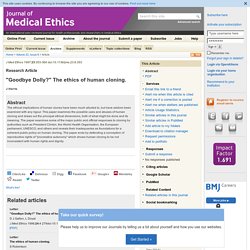
Human Cloning. Silver is a Professor of Genetics at Princeton University where his laboratory is attempting to identify genes that influence personality and behavior.

You predicted, I think two years ago, that human cloning would be here with us, within two years. I don't think I said that ... I predicted that human cloning would be with us in 10 years and I still believe that is the case, because there is a demand among a small number of people for this technology to have babies. It's being driven by the marketplace. Scientists in ‘Japan Clone 98 % Pure Saber-Tooth Tiger’ is Fake; There's No Baby ‘Ryu’ Scientists in Japan Clone 98% Pure Saber-Tooth Tiger. Japanese scientists have successfully cloned a 98 percent pure Saber-Tooth Tiger at the Japanese government-funded laboratory, Riken Center for Development Biology.
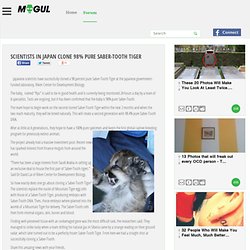
The baby, named "Ryu" is said to be in good health and is currently being monitored 24 hours a day by a team of 6 specialists. Tests are ongoing, but it has been confirmed that the baby is 98% pure Saber-Tooth. The team hope to begin work on the second cloned Saber-Tooth Tiger within the next 2 months and when the two reach maturity, they will be breed naturally. This will create a second generation with 98.4% pure Saber-Tooth DNA.
After as little as 6 generations, they hope to have a 100% pure specimen and begin the first global captive breeding program for previously extinct animals. The project already had a massive investment pool. Chinese 'have cloned 30 human embryos' Chinese scientists have created at least 30 cloned human embryos as a source of cells for medical treatments, it was claimed last night.
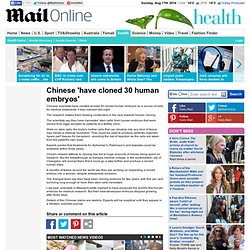
The research makes them leading contenders in the race towards human cloning. The scientists say they have harvested 'stem cells' from human embryos that were cloned from eggs donated by patients at a fertility clinic. Work on stem cells, the body's mother cells that can develop into any kind of tissue, may herald a medical revolution. They could be used to produce perfectly-matched 'spare part' tissues for transplant - avoiding the risk of rejection as the cells are taken from the patient's own body Experts predict that treatments for Alzheimer's, Parkinson's and diabetes could be available within three years.
Patent Granted for Fraudulent Science. Missing from the coverage are two important facts: #1.

The claims of the issued patent US 8,647,872 depend from the deposited cell line. If the work on the deposited cell line is inaccurate (which is likely so), the claims do no damage to anyone. Who is going to infringe the claims? #2. As to being "shocked," what about the initial response by the journal Science, who described the problem initially as an issue with figures?
As to Mr. Stem cell breakthrough could reopen clone wars - opinion - 29 January 2014. The ability to easily reprogram any cell to an embryonic state will inevitably bring out maverick human cloners.
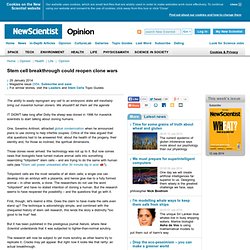
We shouldn't let them set the agenda IT DIDN'T take long after Dolly the sheep was cloned in 1996 for maverick scientists to start talking about cloning humans. One, Severino Antinori, attracted global condemnation when he announced plans to use cloning to help infertile couples. Critics of the idea argued that vital questions had to be answered first: about the health of the progeny, their identity and, for those so inclined, the spiritual dimensions. Those clones never arrived: the technology was not up to it. WA s top doctor backs human cloning. WA's top doctor wants politicians to consider allowing the creation of human embryos from the DNA of more than two people to create babies which are impervious to some genetic diseases.

Chief medical officer Simon Towler has reopened the divisive debate about embryonic stemcell research, saying politicians should revisit the legislation which was shot down three years ago in a conscience vote in State Parliament. In a previously confidential submission to a committee reviewing the Commonwealth's reproduction technology laws, Dr Towler highlighted the benefits of lifting the nationwide ban on creating embryos which contain genetic material from more than two people. Could Human Beings Be Cloned? The news that researchers have used cloning to make human embryos for the purpose of producing stem cells may have some people wondering if it would ever be possible to clone a person.
Although it would be unethical, experts say it is likely biologically possible to clone a human being. But even putting ethics aside, the sheer amount of resources needed to do it is a significant barrier. Since the 1950s when researchers cloned a frog, scientists have cloned dozens of animal species, including mice, cats, sheep, pigs and cows. Human Cloning Foundation Home Page.
Activity_5-1_stem_cell_opinion_poll. Skin cells cloned into embryonic cells › News in Science (ABC Science) News in Science Thursday, 16 May 2013 ABC/AFP Stem cell breakthrough A breakthrough in stem cell research has been achieved with scientists using cloning techniques to turn human skin cells into embryonic stem cells. While scientists have previously been able to make embryonic stem cells using this approach in monkeys and mice, until now they have not been able to this with human cells. Embryonic stem cells can turn into any other cell type in the body, raising the hope this new method could be used for developing personalised therapies, such as creating replacement organs. While the study was lauded by Australian experts in the field, the ethics and cost of the process did raise concerns. The work, published today in Cell , uses somatic cell nuclear transfer (SCNT) - the process used to clone Dolly the Sheep.
This process involves placing the genetic material from a body cell, such as a skin cell, and transferring it into an unfertilised donor egg that has had its genetic material removed. Surprising interview with Nobel Laureate John Gurdon on human cloning - Knoepfler Lab Stem Cell BlogKnoepfler Lab Stem Cell Blog. Human cloning is an important issue at both scientific and societal levels. Earlier I included a guest post from bioethicist, Arthur Caplan, on human cloning.
Today I am posting a short Q&A with Nobel Laureate John Gurdon. I asked Gurdon three specific questions and below each I have listed his answer. My sense is that he is not very enthusiastic about the idea of human reproductive cloning. 1.)
The Coming Public Conflict Over Human Cloning. This week, the U.S. Supreme Court refused to hear a last-ditch legal challenge to federal funding of embryonic stem cell research (ESCR). Ten years ago that decision would have generated celebratory headlines and heated public debate. Instead, the news came and went with barely a whisper. Why did this issue age and fade so quickly? First, I’d submit, the public no longer believes the stem cell hype. Second, stem cell science has moved on. Finally, President Bush’s controversial ESCR funding policy was repealed by President Obama early in his first term. P Zavos. Hwang Woo-Suk. S Antinori. Park Se Pil.